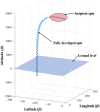Data-driven flight path monitoring technique using recurrent neural network for the safety management of commercial aircraft
- PMID: 40134866
- PMCID: PMC11935752
- DOI: 10.7717/peerj-cs.2753
Data-driven flight path monitoring technique using recurrent neural network for the safety management of commercial aircraft
Abstract
Aviation spins, particularly at low altitudes, significantly contribute to fatalities due to limited recovery time. Standard recovery procedures typically only become eligible after a spin is fully developed, by which time multiple turns may have already resulted in substantial altitude loss. The primary challenge in upset prevention is heavy reliance on the pilot's situational awareness, which is only effective before the spin has been fully developed. To address this issue, this study proposes an early detection capability to significantly enhance immediate response actions, potentially mitigating altitude loss and enabling pilots to recognize the initial signs of upset conditions. This research introduces a real-time predictive tool based on a novel recurrent neural network (RNN) model that utilizes data from the NASA Generic Transport Model (GTM)-a research platform designed for experimental flight case studies-to predict nonlinear flight responses during the critical initial seconds of a spin. Rigorous validation against ground truth data demonstrates the RNN model's superior predictive capabilities in detecting incipient spin phase, offering an essential tool for proactive spin management and reducing the risk of ground collisions. This early detection capability empowers pilots to identify the initial signs of upset conditions and make informed operational decisions, ultimately improving aviation safety. This advancement underscores the potential of advanced machine learning technologies to transform safety protocols by enabling earlier and more effective intervention strategies, thereby preempting catastrophic events.
Keywords: Air traffic management; Flight safety; Incipient spin detection; Machine learning-based flight monitoring.
© 2025 Kim et al.
Conflict of interest statement
The authors declare that they have no competing interests.
Figures










References
-
- Amos B, Kolter JZ. OptNet: differentiable optimization as a layer in neural networks. Proceedings of the 34th International Conference on Machine Learning; PMLR; 2017. pp. 136–145.
-
- Anderson SB. Historical overview of stall/spin characteristics of general aviation aircraft. Journal of Aircraft. 1979;16(7):455–461. doi: 10.2514/3.58548. - DOI
-
- Ayhan S, Samet H. Aircraft trajectory prediction made easy with predictive analytics. Proceedings of the 22nd ACM SIGKDD International Conference on Knowledge Discovery and Data Mining. KDD ’16; New York, NY, USA: Association for Computing Machinery; 2016. pp. 21–30. - DOI
-
- Babl M, Engelbrecht J. Automatic deep stall recovery using optimal trajectory planning. IFAC-PapersOnLine. 2020;53(2):15508–15515. doi: 10.1016/j.ifacol.2020.12.2377. - DOI
-
- Bacon B, Gregory I. General equations of motion for a damaged asymmetric aircraft. AIAA Atmospheric Flight Mechanics Conference and Exhibit; Hilton Head, South Carolina: American Institute of Aeronautics and Astronautics; 2007. - DOI
LinkOut - more resources
Full Text Sources
